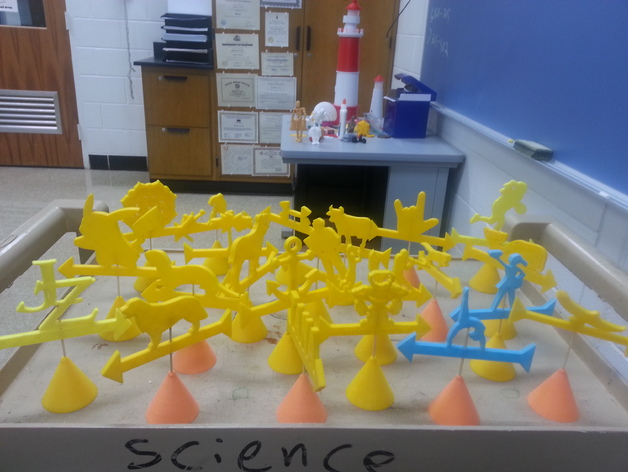
Weather Vane Spinner Project
thingiverse
https://youtu.be/XEXLeQUbBTU This is a sixth-grade project designed to complement a unit on weather. Students will design and 3D print a spinning weather vane using Tinkercad. The goal of this activity is for students to become proficient in 3D design while building weather tools, which can be an elementary science activity suitable for grades younger than six. Skills / Tools Emphasized in This Lesson Using the shift key to resize objects without changing their proportions Rotating shapes Utilizing the Adjust - Align tool to center objects The project employs 4" bamboo skewers from grocery stores as the shaft of the spinner. These skewers fit perfectly into a 4 mm socket. If you use different size skewers, adjust the size of the socket accordingly. Standards NGSS Overview and Background Students will utilize Tinkercad to design a spinning weather vane. Lesson Plan and Activity Base - these are all identical, so print them ahead of time Drag a cone onto the workplane Enlarge so the base is 50 mm in diameter (using the shift key keeps the base round) Drag a cylinder onto the workplane and make it a hole Resize so the diameter of the cylinder is 4 mm and taller than the cone Select the cone and cylinder, then use the Adjust -> Align tool to center the cylinder on the cone Lift the cylinder 2 mm off the workplane so the hole doesn't go all the way through the cone Drag a box onto the workplane and resize it to be 100 mm long (x), 10 mm wide (y), 6 mm high (z-direction) Drag a roof onto the workplane and rotate it to point to the right Resize the roof to be an isosceles triangle 16 mm long (x), 32 mm wide (Y), and 6 mm high (z) Check that the roof is on the workplane, lift it up if necessary Duplicate the roof Move one triangular roof piece to the front of the arrow and the other to the back of the arrow Group the box and roof pieces to complete the arrow Atop the Arrow Students can customize their weather vane by adding a design of their choice atop the arrow. This can be done using shapes and letters from Tinkercad or importing a silhouette in SVG format. The objects added should be flat and 6mm in height (z) to match the size of the arrow. They should be aligned so the center of mass will be above the center of the arrow, ensuring it's not front or back heavy. Add Socket to Arrow Drag a cylinder onto the workplane Make it a hole Resize so the diameter is 4 mm and length is 40 mm Rotate the cylinder so it is parallel to the work plane along the y-axis, perpendicular to the arrow Use the Adjust - Align tool to center the cylinder on the arrow, ensuring it's centered in x, y, and z directions The cylinder should extend a hole up through the bottom of the arrow and into the shape above. Make sure it doesn't go all the way through. A hole about 35 mm long will work well. Longer holes may cause the spinner to touch the base, while shorter ones won't provide stability. Materials Needed Some 4" bamboo skewers from the supermarket. Various sizes are available; just check the fit before doing the project with students.
With this file you will be able to print Weather Vane Spinner Project with your 3D printer. Click on the button and save the file on your computer to work, edit or customize your design. You can also find more 3D designs for printers on Weather Vane Spinner Project.
